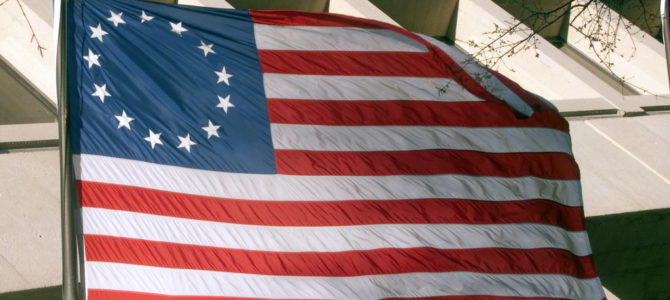
Nike’s decision to pull shoes depicting the Betsy Ross flag from the market because it might offend someone shows a gross lack of knowledge about the flag’s true meaning and origin. It’s time to dispel the myths about this flag and set the record straight.
The Betsy Ross flag is not a colonial flag. It is the first official flag of the United States of America.
The Betsy Ross flag is the first flag of the United States of America, not of Britain’s American colonies. Independence Day, July 4, 1776, marks the day that the Declaration of Independence changed the American colonies into states.
While submitting to the authority of the Continental Congress, the new states began to set up new state governments and write new state constitutions. At the same time, Gen. George Washington knew that his army and the American people needed a new flag to symbolize this change from a government based on royalty to one based on representation. Betsy Ross, a known upholsterer in Philadelphia, sewed the first flag, according to sworn affidavits given by her descendants.
When Congress officially issued this flag on June 14, 1777, they emphasized the symbolism of the thirteen new states, not the thirteen colonies. “Resolved, That the flag of the thirteen United States be thirteen stripes, alternate red and white: that the union be thirteen stars, white in a blue field, representing a new constellation,” declared the Journal of the Continental Congress on June 14, 1777.
The first flag of the United States was not about slavery. It was about unity.
The key word in Congress’s description of this flag is “union.” The meaning of the first flag of the United States is unity. What could be more plain and simple than that? What could be more worthy and noble than a flag with a literal meaning of union? Nike rejected a flag that means unity.
Ross sewed the 13 stars in a circle, uniting them into one. A circle symbolizes equality because no one star is more prominent or important than another. This meant that no state was more important than another state. The same is true today.
America could not achieve freedom in any form without unity among the original 13 states. As long as England controlled territory in any of the states, regardless of whether those states legally allowed slavery or not, the United States could not exist and govern as a secure, independent country. America would have been constantly under threat from foreign invasion as long as any state remained controlled by England and not the U.S. government.
Declaring the first flag of the United States as offensive denigrates the African Americans who fought for this flag.
Nike claims that they rejected this flag because it might offend someone. In doing so they offended the memory of everyone, including African-Americans both slave and free, who put their lives on the line for that 13-starred flag.
Men, women, rich, poor, black and white—all fought and made sacrifices for the principles and aspirations that this flag represents. After the last major battle of the American Revolution, Congress deepened the flag’s meaning by defining red, white and blue.
“White signifies purity and innocence. Red hardiness and valor and Blue … signifies vigilance perseverance and justice,” the Journal of the Continental Congress recorded on June 20, 1782.
Why didn’t Congress define the colors when they first adopted the flag in 1777? They didn’t really know what the colors meant at the start of the United States. By the end of the revolution, they knew what those colors meant because they understood the cost of freedom.
They knew that a free African-American named Peter Salem lived for the red stripe of valor when he risked his life at Bunker Hill to take out the British major responsible for the first British shots of the war. Because of Salem’s story, more Africans were freed and fought. Salem fought for four years and Africans made up about four percent of the Continental Army.
They knew that the flag’s maker, Betsy Ross, was an antislavery Quaker. Her second husband, Joseph Ashburn, was thrown into a British prison for “piracy, treason and rebellion against His Majesty on the high seas.” Representing the white stripe’s pure motive of loyalty, he died because he pledged allegiance to the flag of unity that his wife first sewed.
They knew that a slave named James Armistead represented the color blue because his vigilance as a spy led to America’s victory in the final battle at Yorktown in 1781. Without Armistead’s intelligence as a servant to British General Cornwallis, General Lafayette would not have been able to notify Washington that seizing Yorktown was possible. When Amistead became a free man, he changed his name to James Lafayette.
Yes, it’s unfortunately true that slavery existed when America was founded. It’s unfortunately true that freedom was not equally applied after the American Revolution, with only states in the North abolishing slavery over our nation’s initial years and first decades. It is unfortunately true that the quest for freedom and civil rights for all has been a long, hard-fought battle.
It’s also true that America did not change the design of its flag after slavery was abolished. Why? The nation’s leaders after the Civil War did not see a need to alter the flag’s appearance because they outlawed slavery under it. The American flag—the Union flag—was the victor in the Civil War. Except for adding stars each time a state enters the Union, our flag has not changed since the Betsy Ross flag.
The flag’s meaning of unity has not changed. The values of the colors—valor, hardiness, purity, innocence, justice, perseverance, and vigilance—have not changed. The flag has been enhanced and made more brilliant as we have expanded and deepened the meaning of unity and freedom. That is something to celebrate, not denigrate like Nike by refusing to sell a shoe featuring the first flag of the United States of America.









